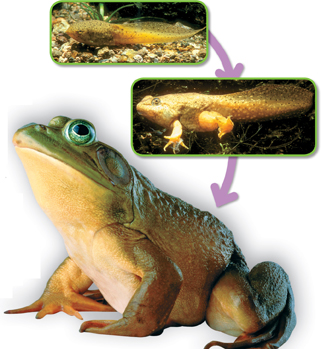Environmental Influences You've seen how cell differentiation is controlled at least in part by the regulation of gene expression. Conditions in an organism's environment play a role too. In prokaryotes and eukaryotes, environmental factors like temperature, salinity, and nutrient availability can influence gene expression. One example: The lac operon in E. coli is switched on only when lactose is the only food source in the bacteria's environment.
Metamorphosis is another well-studied example of how organisms can modify gene expression in response to change in their environment. Metamorphosis involves a series of transformations from one life stage to another. It is typically regulated by a number of external (environmental) and internal (hormonal) factors. As organisms move from larval to adult stages, their body cells differentiate to form new organs. At the same time, old organs are lost through cell death.
Consider the metamorphosis of a tadpole into a bullfrog, as shown in Figure 13–21. Under less than ideal conditions—a drying pond, a high density of predators, low amounts of food—tadpoles may speed up their metamorphosis. In other words, the speed of metamorphosis is determined by various environmental changes that are translated into hormonal changes, with the hormones functioning at the molecular level. Other environmental influences include temperature and population size.

FIGURE 13–21 Metamorphosis Environmental factors can affect gene regulation. If the bullfrog's environment changes for the worse, its genes will direct the production of hormones to speed the transformation of the tadpole (top photo) to the adult bullfrog (bottom photo).
13.4 Assessment

-
Review How is the lac operon regulated?
Explain What is a promoter?
Use Analogies Write an analogy that demonstrates how the lac repressor functions.
-
Review Describe how most eukaryotic genes are controlled.
Compare and Contrast How is gene regulation in prokaryotes and eukaryotes similar? How is it different?
-
Review What genes control cell differentiation during development?
Compare and Contrast How is the way Hox genes are expressed in mice similar to the way they are expressed in fruit flies? How is it different?
PRACTICE PROBLEMS
A hormone is a chemical that is produced in one part of the body, travels through the blood, and affects cells in other parts of the body. Many hormones are proteins. How might the production of a hormone affect the expression of genes in a eukaryotic cell? Write a hypothesis that could be tested to answer this question. (Hint: Include promoters in your hypothesis.)

Table of Contents
- Formulas and Equations
- Applying Formulas and Equations
- Mean, Median, and Mode
- Estimation
- Using Measurements in Calculations
- Effects of Measurement Errors
- Accuracy
- Precision
- Comparing Accuracy and Precision
- Significant Figures
- Calculating With Significant Figures
- Scientific Notation
- Calculating With Scientific Notation
- Dimensional Analysis
- Applying Dimensional Analysis




